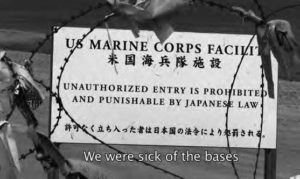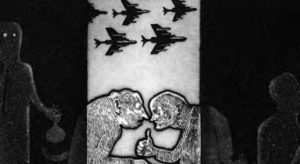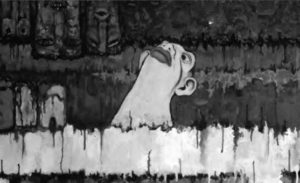DIRECTED BY LINDA HOAGLUND, PRODUCED BY NEW DAY FILMS, 2010
JAPANESE WITH ENGLISH SUBTITLES, 89 MINUTES
ANPO is an intriguing mix of anti-war paintings, documentary, feature film, anime (animation) clips, interviews with the artists in Japanese with English subtitles, and brief English language comments by author and CIA critic Tim Weiner. Although there are references to such things as Japanese atrocities in World War II and the terror felt by victims of American firebombing, most of the emphasis is on the massive protests that broke out in 1960, when Prime Minister Kishi Nobusuke ejected protesting Socialist Party members and rammed through an extension of the US-Japan Security Treaty, popularly known as ANPO. That sort of USJapan relationship, asserts Weiner, was like “a prostitute and a pimp.”
Most of the emphasis is on the massive protests that broke out in 1960, when Prime Minister Kishi Nobusuke ejected protesting Socialist Party members and rammed through an extension of the US-Japan Security Treaty, popularly known as ANPO.

High school and college teachers interested in presenting this point of view will obviously have to excerpt segments from this long work that fit their classroom needs. In the process, they can avoid parts (a portrait of a disabled person with a bare derriere, for example) that might not fit their students’ age level. The film will also require supplementary reading and student preparation. Teachers interested in prejudice in Japan, for example, should note that the discussion of the 1957 uproar over the shooting of a Japanese woman illegally collecting brass shells on a US base (the Girard case) fails to mention the fact that the woman was a member of an outcast group traditionally known as Burakumin. “[W]ithout understanding this facet of the case,” note George DeVos and Hiroshi Wagatsuma in their classic study, “the vehemence of the protest by leftist organizations and the indifference by a large majority of Japanese is incomprehensible.”1

This DVD gives us a better picture of traditionally left-wing Japanese artists and intellectuals than it does of the nation as a whole.

http://www.anpomovie.com. ©2011 AnPO movie, llC.
Supplementary readings and commentary explaining the 1960 ANPO demonstrations are even more crucial. The DVD’s film clips do note that Prime Minister Kishi had once been indicted (but not tried) by the Allied Occupation authorities as a war criminal. There is also a brief scene showing Kishi’s decision to bring police forces into the Diet (Parliament) to eject Japan Socialist Party members who were trying to block treaty ratification by a sit-in. Most of the film clips, however, simply show thousands of Japanese marching or doing a classic Japanese “snake-dance” of protest. While these scenes are said to prove how many Japanese rejected the 1960 US alliance and militarism, George Packard’s classic work on the 1960 events suggests that Japanese were mainly angered by the undemocratic way in which Prime Minister Kishi attempted to get the treaty passed. One cannot read his work without thinking that, for many Japanese, domestic politics, not the US alliance or militarism, was the key issue.2

http://www.anpomovie.com. ©2011 AnPO movie, llC.
Put another way, this DVD gives us a better picture of traditionally leftwing Japanese artists and intellectuals than it does of the nation as a whole. Few Japanese particularly like American bases. The DVD illuminates the obvious facts that these bases encourage a seamy bar and prostitute culture and run the danger of linking Japan to American military adventures. Furthermore, far too many of these bases are in Okinawa rather than in Japan as a whole, causing resentment that, for example, forced the newly elected Prime Minister Hatoyama Yukio to resign in 2010 when he could not solve the problem. Yet many in Japan fear both an expanding China and an unpredictably dangerous North Korea. Like much of the rest of Asia, they probably prefer US bases, rather than a greatly expanded Japanese military. Teachers using this DVD thus need to stress that while memories of the war and the political struggles of the 1960s are still vivid for many, they are hardly the whole story in a nation as conservative, varied, and vibrant as Japan.
NOTES
- George DeVos and Hiroshi Wagatsuma, Japan’s Invisible Race: Caste in Culture and Personality (Berkeley: University of California Press, 1967), 78–79. Some prefer “Dowa Community” to Burakumin.
- George R. Packard, Protest in Tokyo: The Security Treaty Crisis of 1960 (Westport, CT: Greenwood Publishing, 1978).

